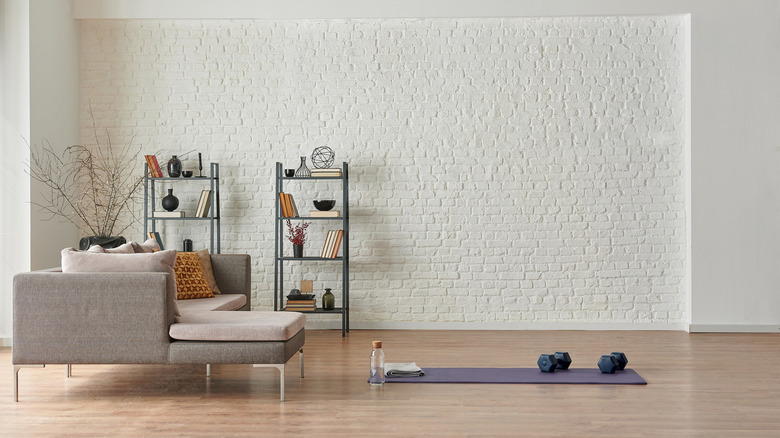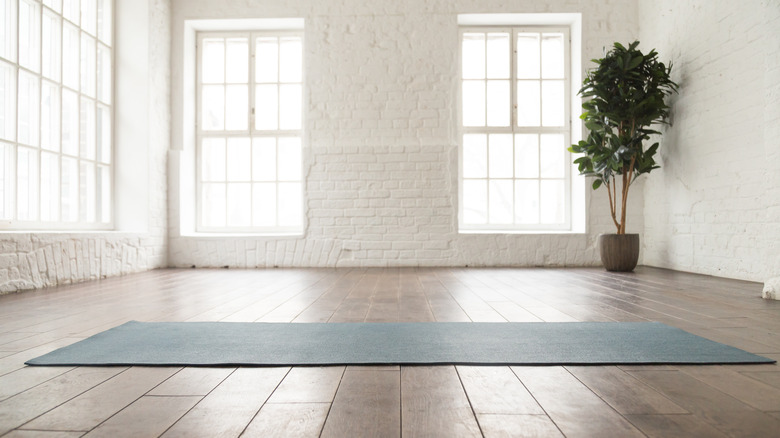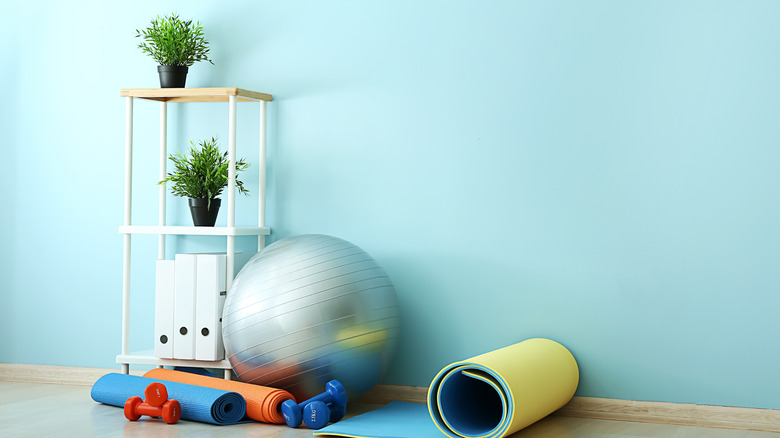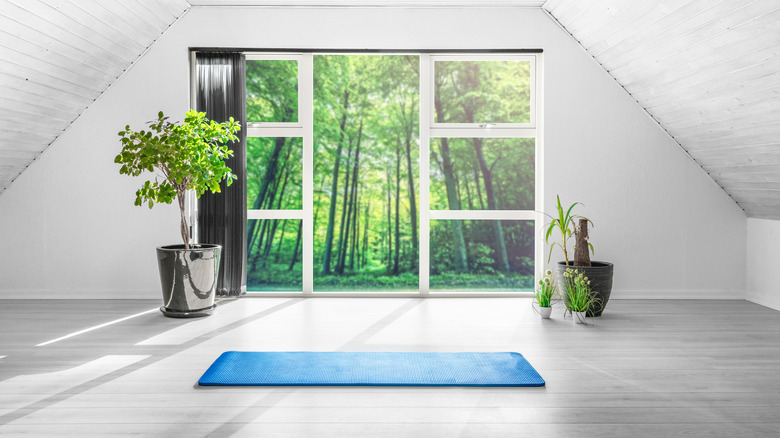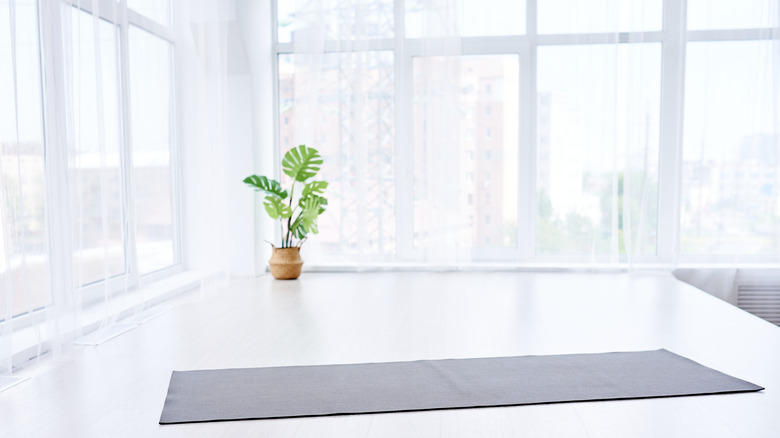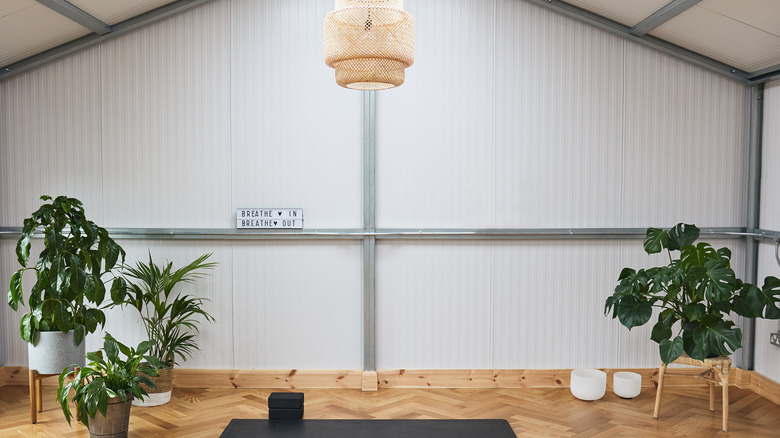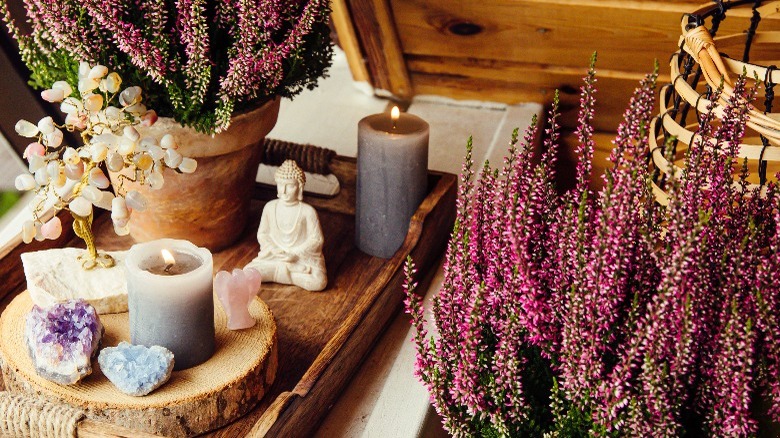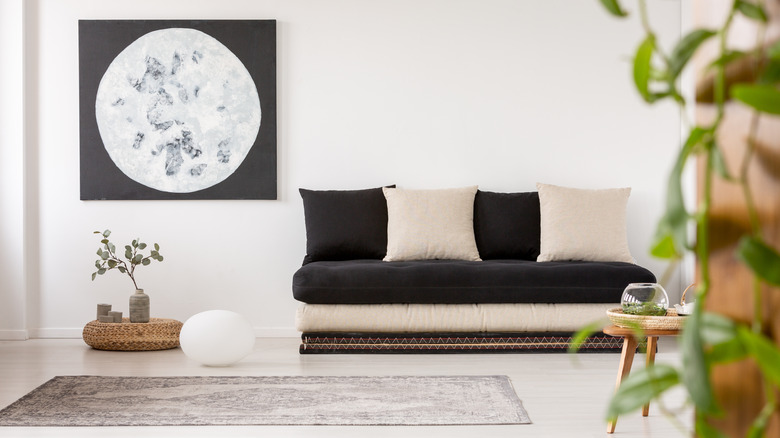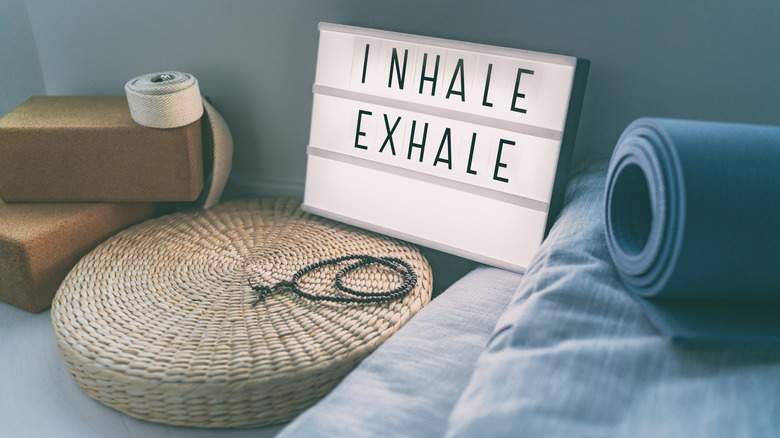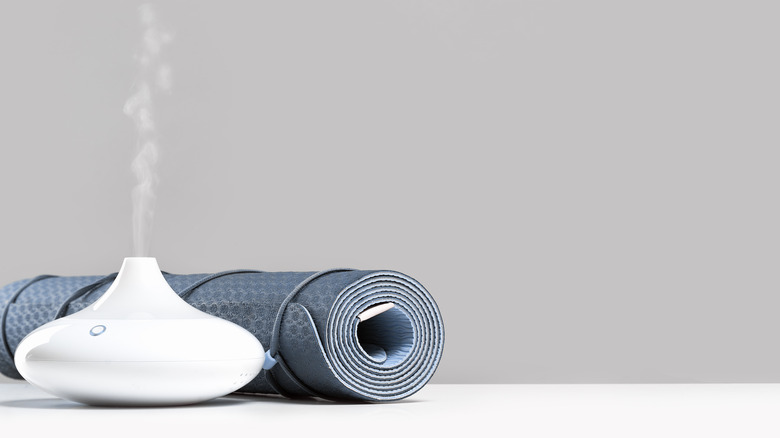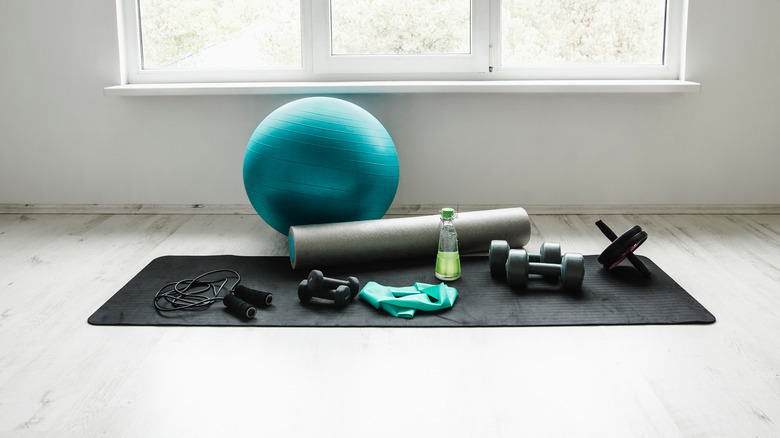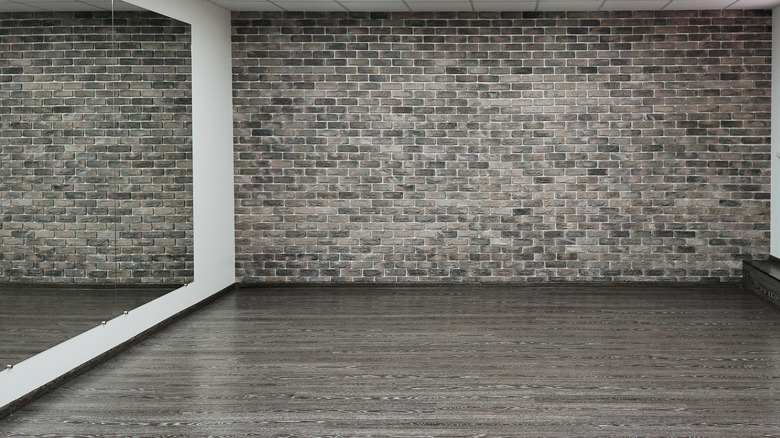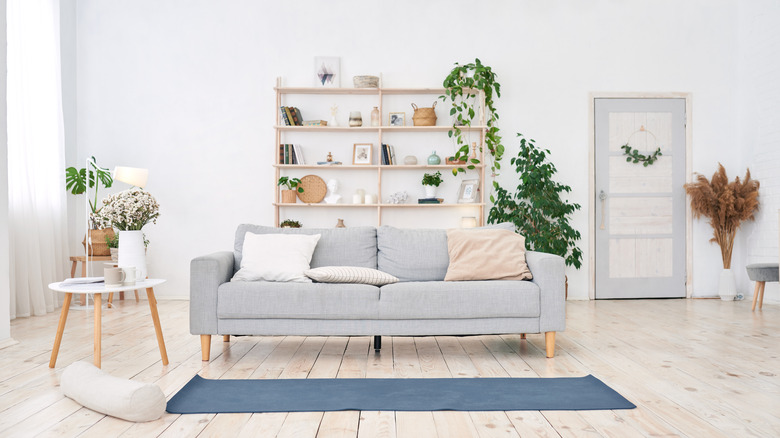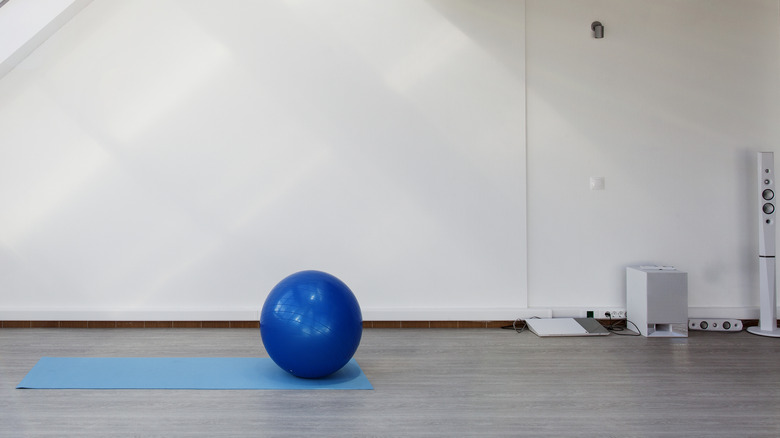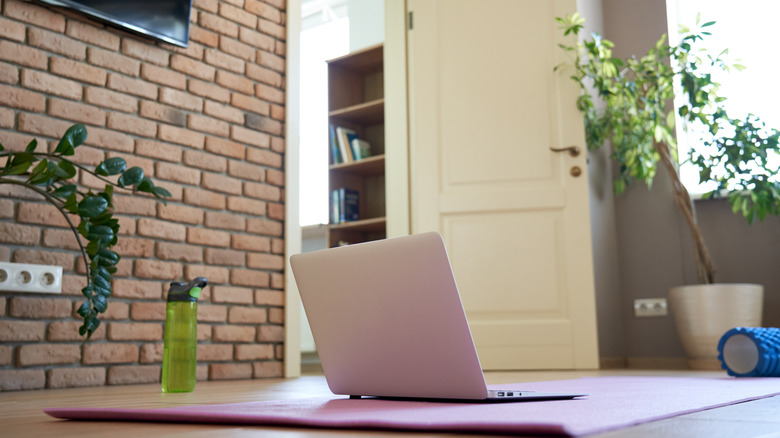How To Create A Yoga Space At Home
Yoga has been around for thousands of years, but it has become even more prominent in recent years as people have realized the benefits it can provide for the mind, body, and soul. According to Johns Hopkins Medicine, practicing yoga improves your physical, mental, and spiritual well-being. It can control and calm the mind while teaching you focus, strength, and flexibility. Yoga originated in Northern India over 5,000 years ago and has spread to cultures worldwide (via Yoga Basics).
While there are studios, retreats, and schools where you can learn and practice yoga in person, many individuals feel more at ease practicing in their own homes and by themselves. Since we live in an increasingly digital world, accessing yoga videos and classes at home is simple. Whether you want to try out a video from Yoga with Adriene on YouTube or download a yoga-based app like Gaia, there are plenty of ways to practice downward dog and other poses. However, before you dive into at-home yoga, consider creating a dedicated yoga space where you can practice in comfort. It's not a good idea to throw your yoga mat down in just any corner of the house. Here are some tips for making a serene yoga area in your home.
Go for a minimalistic approach
The first step you should take to create your yoga space is to declutter your home. Choose a room, preferably one that is big enough (but not too big) for your yoga and creativity needs, and then start decluttering. Having too much clutter around can be stressful, cause unwanted distractions, and may defeat the purpose of creating an at-home yoga space where you can practice relaxation and calming techniques.
According to Psychology Today, cleaning and organizing your belongings can help reduce anxiety which is the first step to beginning your yoga journey. Decluttering can also provide you with benefits for your yoga practice, like energy and confidence. Clearing a space of clutter will make you want to keep accomplishing items on your to-do list. Keep in mind that minimalist decor doesn't mean blank or empty space — it just means getting rid of unnecessary objects that might interfere with your concentration and focus, which are essential when practicing yoga.
Figure out your color scheme
To make your yoga space feel soothing, focus on the color scheme. There are many colors to choose from associated with relaxation and tranquility. From blues and greens to yellows and greys, color can be comforting. According to The Times of India, looking at specific colors can promote relaxation. Colors can even be a tool to manage stress when you're feeling overwhelmed.
In regards to color, light blue paint colors are the ultimate representation of peace and tranquility. If you want to take a subtle approach, periwinkle is an ideal shade of blue for your walls. If you're more a fan of neutral colors, that's also okay. Try out some earthy tones to help you feel more connected to nature. Grey is a great color choice and can help soothe and calm you. Still unsure? You could always opt for something bright and fun, like sunshine yellow or hot pink.
Add in some plants
Plants do more than make your space look pretty. They can also prove beneficial to your mood and creativity and improve the air quality in your home, which, in turn, offers health benefits. According to Flower Aura, some of the most stress-relieving plants are basil, jasmine, aloe vera, snake, and lavender. Succulents are also a good choice for adding a natural element to the room and improving focus. These plants have many other benefits and are relatively easy to maintain. Pick plants that spark joy and make you feel at peace during your yoga practice.
However, some plants may not be suitable for everyone. Some varieties possess poisonous qualities that can harm children and pets, so do your research before deciding what plant or plants you want to purchase for your yoga space. Still, no matter what your aesthetic is, you're sure to be able to find the perfect plant to match your style.
Consider replacing your lights or light source
Lighting has a significant effect on our mood and productivity. While those bright, artificial lights might seem like a good choice, natural light positively impacts our mental and physical well-being. According to ArchDaily, there are some disadvantages to using artificial light sources versus natural light sources in your home.
If you don't have enough windows in your yoga space, don't fret! You can use soft or warm lights, which are also a great way to improve mood and efficiency. In addition to these benefits, soft lighting is not as harsh on your eyes and can even help you unwind in your space. Another type of light that helps improve cognitive function, mood, and alertness is blue light. Still, it also has disadvantages and should be used in moderation. Also, be sure to limit the use of blue light around bedtime since it can have adverse effects on your sleep.
Use earth tones and wood to furnish your space
If you want your yoga space to be a warm and welcoming environment, decorate your space with care. Using earth tones can give you that warm and cozy feeling instead of making your room feel dull and unwelcoming. Not to mention there are a lot of benefits when it comes to using natural wood in your interiors.
According to experts at Just Wood Furniture, wood is generally cheaper than other materials. Plus, it's environmentally friendly, durable, and versatile. There are many different types of wood to choose from, including maple, mahogany, and cherry. When adding wood furniture to your yoga space, try incorporating an oak bookcase, wall shelves, or a chest to store your yoga props and fuzzy blankets for savasana. A pine or cedar wood table with drawers or a cube-organizer is a nice touch and could give you even more space to store your items when not in use.
Crystals can add a nice touch and a splash of color
If you're decorating with earth tones, you might want to add a subtle splash of color with crystals. Crystals have risen in popularity in recent years. They offer aesthetic benefits for your space and may also help boost mood and productivity levels. Plus, they are known for their healing powers and spiritual purposes. According to Vox Magazine, the sudden craze for crystals stems from the millennial and Gen Z population.
However, many older generations have believed in crystal healing and its spiritual properties for decades. It would only be natural to want to include crystals in your yoga space. While you can use these bright and beautiful stones for decoration, you may also find value in using them for spiritual awakenings, healing, and mental stimulation during your yoga practice. Some of the most popular crystals include clear quartz for the energetic system, jasper for stress reduction, amethyst for healing, and obsidian for letting go (via Healthline).
Hang up some tapestries
Some artwork can be overwhelming and create too much visual clutter on the walls. You can solve this problem by hanging up a simple tapestry or two in your yoga space. These fabric-based art pieces come in many different patterns and color schemes. They will help improve your yoga space by adding a cozy and peaceful feeling to the room. According to Street Directory, these decorative pieces are recently growing in popularity for home decor. These hanging wall pieces aren't just for looks, though. Like many other decorative objects, they can improve your mood and mind, which benefits your yoga practice.
Depending on the tapestry you choose and its history, you may feel happiness, peace, or comfort. Some tapestries can even evoke feelings of drama and romance. Be mindful of what type of environment you want your yoga space to be. Once you have an answer, you can choose the tapestry that best fits your ideal setting.
Inspirational phrases can provide motivation
Inspirational phrases add a nice touch to your walls. Plus, they can lift your mood and provide you with some motivation during an intense vinyasa class. There's plenty to choose from, catering to many of life's challenges, including feeling down, unmotivated, or hopeless. You can also search for a yoga-related phrase, like "Inhale, Exhale," or "Namaste."
Adding these phrases to posters or lightboxes in your yoga space will help remind you why you're doing what you're doing and that you should keep moving forward to improve yourself and your life. According to Inspirationfeed, even researchers are starting to look into the benefits of these motivational posters and images. No matter what you need motivation for, you're likely to find a quote that fits the positive and uplifting message you need to receive. Hanging these posters in your yoga space can help remind and motivate you toward your goals and push you to continue your yoga journey.
Fill your space with a soothing scent
Essential oils provide a fresh and delightful smell that, according to Homesick, can help to calm and ease your mind, reduce stress and anxiety, and diminish muscle aches and pains. There are so many physical and mental benefits to using these oils that you will definitely want to add some into your yoga space. There are many essential oil aromas for people to choose from, so finding one you like shouldn't be difficult.
Some of the most popular scents include lavender, peppermint, lemongrass, cinnamon, and citrus. Most of them come with specific benefits. For example, peppermint can help improve energy levels, lavender can relieve stress, and rose can elevate your mood and lessen feelings of anxiety, all of which are beneficial for your yoga space. However, if you have pets, ensure that the essential oil fragrance you choose is not harmful. Some oils contain toxic ingredients that may be harmful to your dog or cat.
Remember to get some yoga props
When creating an at-home yoga space, an essential step is to pick out some yoga props. Not sure where to start? According to Parade, some of the must-have yoga accessories that you should incorporate into your yoga space include yoga bolsters, blocks, blankets, sandbags, and, the obvious, a yoga mat.
Consider what type of yoga you will be doing, and choose your props based on that. For example, if you regularly practice yin, a bolster can help your body relax into poses and find proper alignment (via Yin Yoga). They can offer you comfort and support in many different yoga poses. Yoga blocks also help relax your muscles. For example, you can place blocks under your knees in butterfly pose for extra support. Yoga blankets can help with poses such as seated forward fold by providing you with a soft support system and extra cushion, while sandbags assist in relaxing your muscles and grounding your energy. Of course, a yoga mat is essential in keeping your hands and feet from slipping while practicing asanas like downward dog.
Grab a big mirror for your wall
If you've been to a yoga studio before, you've probably seen at least one of the walls filled with full-length mirrors. Using mirrors in yoga is a common practice that can help improve your structure, body position, alignment, and consciousness. According to Yoga Spy, using mirrors in your yoga practice offers many benefits, including strengthening your awareness externally, helping with self-gaze, and increasing alertness.
Plus, seeing your reflection in the mirror as you practice yoga poses may help instill confidence and motivation as you see your progress from class to class. It can also help you see the areas that need improvement or practice. While big mirrors can be expensive, it's better to go for larger ones when using mirrors for your yoga practice. Plus, you're just one person, and you won't need a whole wall of mirrors — just one mirror will do.
Personalize it
Your yoga space is a sanctuary and should include items that make you feel happy, peaceful, and showcase your personality. These items are usually personal and could be photos of your loved ones and furry family members, momentums from recent trips or vacations, and meaningful gifts from your family, friends, or special someone. Cozy Stylist mentions that decorating your home with personal decor can make it feel warm and welcoming, and this benefit can also apply to your yoga space. Incorporating a personalized touch can help your yoga space feel more comforting and bring you peace of mind.
However, be careful not to overdo it. Sometimes simple is better. Try hanging a photo collage on the wall of the people who matter to you most or placing a few mementos throughout the room. You don't need to incorporate too many items into the space — just enough to remind you of your goals and keep you focused on the bigger picture.
Play some music
Whether through a Bluetooth speaker or surround sound system, relaxing instrumental music can help calm and clear your mind. The right music can also make you feel motivated, uplifted, and energized.
According to Audio Factor, listening to instrumental music has several benefits for our lives. For example, this type of music can help improve focus and ground you. This music can also help bring you to a meditative state when practicing yoga. It can allow you to sync your breathing to the beat, which can help you be more mindful of how and when you breathe. You could also try listening to nature sounds to help you feel more connected and at peace with yourself and the world around you. Thundershowers, waterfalls, wind, rustling leaves, or even birds chirping are just some of the many different nature sounds that help you focus and feel connected to nature.
Have a device for streaming sessions
Online yoga is becoming more prominent in our digital age. Whether it's a tablet, mobile device, or laptop, it's essential to have a device to stream your yoga lessons on in your space. You can access plenty of free lessons on YouTube and other similar sites or try paid classes on apps. Either way, having a device to stream your classes is a must-have, especially for beginners who need extra guidance.
According to Daily Cup of Yoga, some other benefits of streaming yoga from the comfort of your own home include choosing when and where to practice your yoga routine, a choice of which class or session to take part in, and the online community that you can join. Plus, you can save time and money on the commute and in-person classes that typically cost more than those online. Who doesn't want to save time and money?
